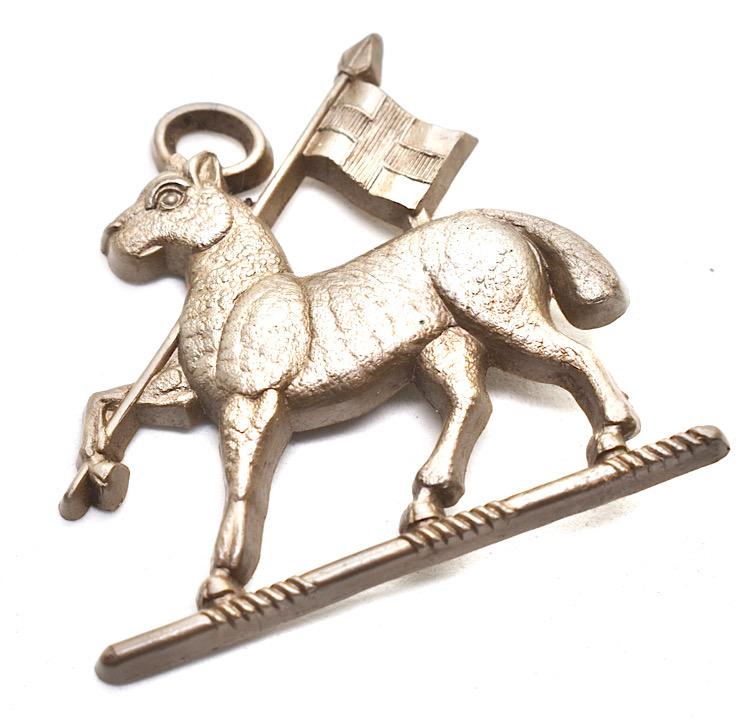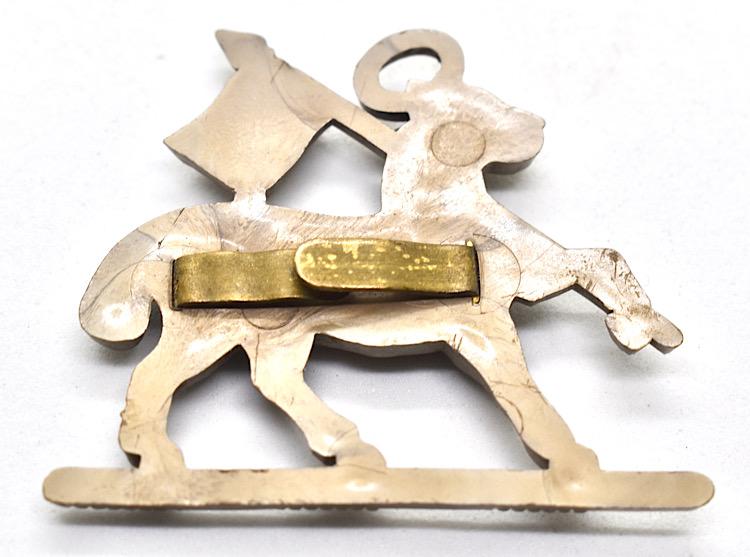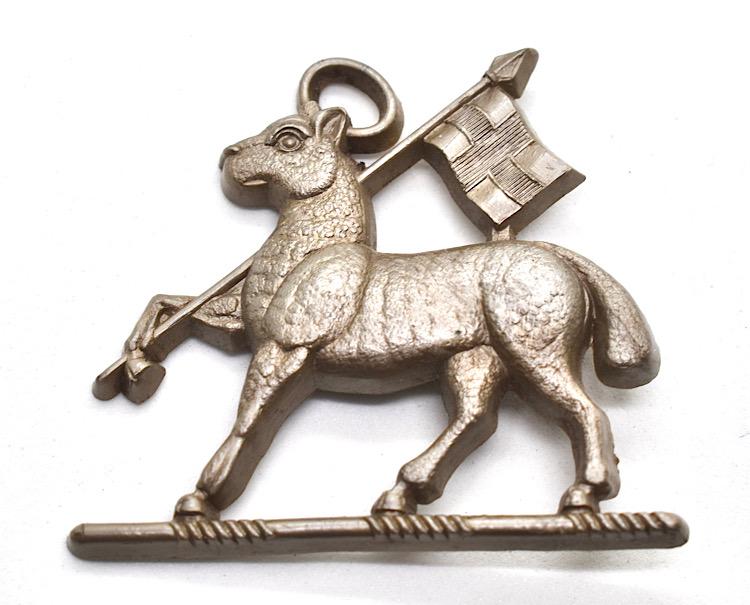British WW2 cap Badge Queen's Royal Regiment (West Surrey)
British WW2 cap Badge Queen's Royal Regiment (West Surrey)
Nice economy (plastic) cap badge of the
“Queen's Royal Regiment” (West Surrey)
The 1st Battalion was serving in British India on the outbreak of the Second World War but did not see action until 1942 against the Imperial Japanese Army. The 1st Queens fought in the Burma Campaign throughout the war as part of the 33rd Indian Infantry Brigade, 7th Indian Infantry Division, of the British Fourteenth Army under Lieutenant General William "Bill" Slim.
A patrol from the 1st Battalion, Queen's Own Royal Regiment (West Surrey), crossing a paddy field where a Burmese tiller is at work with a team of oxen, near Waw, 12–13 July 1945.
The 2nd Battalion, initially commanded by Lieutenant Colonel Robert Ross until April 1940, spent the early years of the war in the Middle East and Syria before also going out to the Far East. They were part of the 16th Brigade, 6th Infantry Division which was later redesignated as the 70th Infantry Division and were involved in Operation Thursday, the second Chindits campaign. The Chindits were the creation of Brigadier Orde Wingate. After suffering heavy casualties in the Chindits campaign, 2nd Queen's reverted to being an ordinary infantry battalion, nicknamed PBI (Poor Bloody Infantry), and served with 29th Infantry Brigade, part of 36th Infantry Division from May 1945 onwards.
Territorial Army
Infantrymen of the 1/7th Battalion, Queen's Royal Regiment (West Surrey) and a Stuart tank in Grazzanise, Italy, 12 October 1943.
The 1/5th, 1/6th, and 1/7th were all 1st Line Territorial Army battalions that were serving in the 131st Infantry Brigade, which was a part of the 44th (Home Counties) Infantry Division, a 1st Line Territorial Army division. The brigade was sent, along with the rest of the division, to France in 1940 to join the British Expeditionary Force (BEF) and were quickly involved in the Battle of France and subsequent Dunkirk evacuation. They arrived in England and the division was led for a while by Major-General Brian Horrocks. The division was later sent to North Africa in mid-1942 to join the British Eighth Army and fought in the Battle of Alam el Halfa and later in the Second Battle of El Alamein where the 131st Brigade was assigned to the 7th Armoured Division and would remain with them for the rest of the war. The brigade participated in the Tunisian and Italian Campaigns and the North West Europe Campaign. In December 1944, due to heavy casualties and a shortage of infantrymen in the British Army, the 1/6th and 1/7th Battalions were replaced by 2nd Battalion, Devonshire Regiment and 9th Battalion, Durham Light Infantry, both from the 50th (Northumbrian) Infantry Division. The 1/6th and 1/7th would spend the rest of the war as training units with the 50th Infantry Division.
Infantrymen of the Queen's Royal Regiment (West Surrey) on the march with messenger dogs near Barham, Kent, 13 October 1941.
The regiment also raised the 2/5th, 2/6th, and 2/7th which were all 2nd Line Territorial Army battalions serving in the 35th Infantry Brigade of the 12th (Eastern) Infantry Division, a 2nd Line Territorial Army duplicate of the 44th (Home Counties) Division. They were also sent to France in 1940 and were involved in the Battle of Dunkirk where they suffered heavy casualties due to the men having very little training. The division was disbanded shortly after returning to England and the 35th Brigade was later redesignated the 169th Infantry Brigade. The 169th Brigade was to serve with the 56th Division for the rest of the war in the Italian Campaign in battles at Salerno, Anzio and in the final Allied offensive in Italy, Operation Grapeshot.
In January 1944 Lieutenant Alec George Horwood of the 1/6th Battalion was awarded the Victoria Cross whilst fighting in the Burma Campaign whilst attached to the 1st Battalion, Northamptonshire Regiment.
63rd (Queen's) Searchlight Regiment served in Anti-Aircraft Command during the Battle of Britain and the Blitz, then converted into 127th (Queen's) Light Anti-Aircraft Regiment, Royal Artillery and manned Bofors guns to protect the Mulberry harbour after D-Day, and then defended Antwerp late in the war.
The regiment raised many other battalions during the war, mainly for home defence or as training units. None of these units saw active service, they remained in the United Kingdom for the duration of war. They fulfilled a role of supplying the battalions overseas with trained infantrymen or were converted into other roles. For example, the 13th Battalion, raised in 1940, was assigned–in an infantry capacity–to the 80th Infantry (Reserve) Division. The 14th Battalion was raised in Dorchester in early July 1940 commanded by Lieutenant Colonel Alexander Wilkinson. and in October the battalion was assigned to the 201st Independent Infantry Brigade (Home) and commenced anti-invasion duties. On 1 December 1941 the battalion was converted into the 99th Light Anti-Aircraft Regiment, Royal Artillery and it subsequently served in Italy.
Overal a very nice British cap badge in very good condition.
Code: 66538








